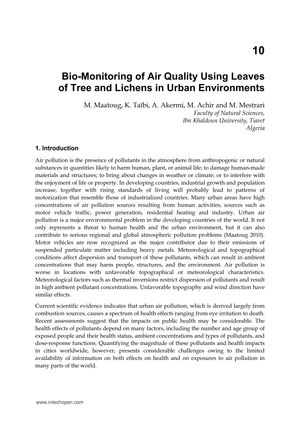Bio-Monitoring of Air Quality Using Leaves of Trees and Lichens in Urban Environments
March 2012
in “
InTech eBooks
”

TLDR Tree leaves and lichens can effectively indicate air pollution levels in cities.
The document from 2012 presents a study on the use of biomonitoring to assess air quality in Tiaret, Algeria, focusing on the accumulation of heavy metals (Pb, Zn, Cu) in the leaves of Platanus acerofolia and Cupressus sempervirens, as well as in the lichen Xanthoria parietina. The study found that the FM/DM ratio of leaves is a reliable indicator of air quality, with lower ratios in polluted areas. Plane tree leaves accumulated more Zn than Pb, while cypress leaves accumulated more Pb than Zn, and Cu was weakly accumulated by plane trees and not at all by cypress. The lichen Xanthoria parietina was found to have a higher capacity to store heavy metals, with lead levels ranging from 76.31 ± 19.02 µg/g to 237.60 ± 7.02 µg/g and zinc levels from 101.4 ± 55.29 µg/g to 1160.72 ± 272.28 µg/g in urban areas with heavy traffic. The study concluded that both lichens and urban trees are effective bioindicators of air pollution and can help identify areas at risk of pollution, emphasizing the need for vehicle emission control to protect urban environments and human health. The number of trees or lichen samples used in the study was not specified, so the strength of the study cannot be assessed based on the number of participants.